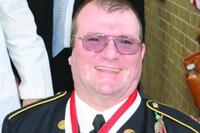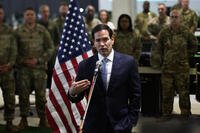Sally Stenton is a retired Air Force judge advocate general who served as the legal adviser to the Afghan Air Force from 2010 to 2011. Dr Forrest Marion served twice as 438th Air Expeditionary Wing historian, in 2009 and 2011.
Lt. Col. Frank Bryant sat at his desk in the makeshift headquarters building of the 438th Air Expeditionary Wing at Kabul International Airport in April 2011. Finishing paperwork after a staff meeting, Bryant was slated to finish his yearlong deployment a month later and was speaking about his beautiful wife, Janice, and their baby boy, Sean, who'd been only two weeks old when Bryant deployed.
The emotions on Bryant's face were easy to read. The love he felt for Janice, the pride when he said Sean's name, and the excitement and relief to be going home in a few weeks were obvious.
Earlier that day, Maj. Raymond Estelle had arrived at the 438th -- Day 1 of his 365-day deployment, the "safe" deployment to Afghanistan, as an adviser to the Afghan Air Force, or AAF. Ray had left at home his wife, Air Force Maj. N'Keiba Estelle; their nine-year-old daughter, Shayla; and 6-week-old son, Raymond III.
Less than 24 hours after Estelle's arrival and Bryant's conversation about going home, both men were dead -- along with six other U.S. airmen and an American contractor.
The NATO Air Training Command-Afghanistan advisers -- or "NATC-A Nine," as they are known -- were killed in action on April 27, 2011. Also killed were Majors Jeffrey Ausborn, Charles Ransom, Philip Ambard and David Brodeur; Capt. Nathan Nylander; Master Sgt. Tara Jacobs Brown; and retired Army Lt. Col. James McLaughlin, who was working as a contractor. They died in an insider attack, the worst in Operation Enduring Freedom and Operation Iraqi Freedom combined.
It has been 10 years since this massacre, the greatest loss of U.S. airmen in a single incident since the 1996 Khobar Towers attack. But the search for truth and justice for them remains elusive. The most important questions remain from day 1: Who, besides the shooter, planned and executed this attack? Will they be brought to justice? Why have U.S. and Afghanistan governments covered up what happened?
It was a beautiful spring morning in Kabul, where the 438th taught and advised the fledgling, and often corrupt, AAF. The day began normally with U.S. advisers and Afghans performing their mission in the Air Command and Control Center, or ACCC. But by 10:45 that morning, nine advisers lay dead or dying and the shooter was dead. Fourteen other Afghans, some armed, who had been in the ACCC, walked out unscathed, and Afghan media was spinning a tale.
The narrative, which continues to this day, was that a lone, crazed gunman turned Rambo with his service handgun and killed the eight armed U.S. airmen and an unarmed contractor; McLaughlin had no weapon. The number of bullets in the bodies of the fallen proved the shooter changed magazines at least twice. Yet no one fired a shot or even drew their weapon. What happened?
The shooter, Afghan Col. Ahmed Gul, left the ACCC and entered the hallway. There, he confronted Nylander and another adviser. Two firefights ensued.
In the first, Gul went down, appearing to be wounded. The second adviser called to Nylander to leave the building. In the chaos and confusion, the adviser, unable to hear over the gunfire, thought Nylander was behind him, but he was not. For reasons we will never know, Nylander did not leave.
In the second firefight, the gunman was wounded twice. An Afghan Quick Reaction Force was shooting into the building. Wounded in both legs, Nylander tried to return fire, but his weapon jammed. There was only one door through which to escape. As Nylander tried to reach it, Gul shot him in the head. For his heroic and courageous actions, Nylander earned a posthumous Silver Star.
The advisers' mission was to work with their Afghan counterparts to develop a professional AAF. But cultural ways of doing business were difficult to overcome. At times, AAF pilots sold seats on aircraft or helicopters. Passenger manifests -- which the advisers tried to implement -- were unwelcome. Some AAF missions were flown with all-Afghan crews and accepted unidentified cargo or passengers at the last minute to fly to locations unknown to the advisers. Training sorties were the priority but, often, Afghan senior leaders called an AAF commander or the pilot of the aircraft to redirect him elsewhere. Advisers called the practice "cell phone command and control," or cell phone C2.
To many advisers, the AAF's operations seemed tantamount to a charter airline used for nefarious purposes, making lots of money for certain individuals.
Among those killed, Bryant, Brodeur and McLaughlin worked with their ACCC counterparts daily. In a nutshell, the ACCC was intended as the national-level C2 nerve center for the AAF. There, AAF personnel might ensure that every flight was properly scheduled, flown and monitored -- and for legitimate purposes.
In mid-April 2011, a new C2 directive went into effect, by order of the Afghan Army's senior general. The directive ended the "cell phone C2" operations. Some Afghan senior leaders greatly resented this and resisted its implementation.
Evidence points to the advisers' anticorruption efforts in the ACCC and AAF as the reason behind the massacre, but the initial U.S. Army report of investigation, or ROI, in 2011 failed to mention the well-known existence of a Criminal Patronage Network functioning within the AAF. Complaints to congressmen and a report by "dirty money expert" Thomas Creal on The Blaze's For The Record news program resulted in a subsequent ROI in 2013 that referred repeatedly to the presence of Criminal Patronage Networks.
Creal said he traced $250,000 paid to Gul by the Criminal Patronage Network before the massacre. Despite this evidence, the 2013 ROI could not link Gul to the network.
The 2013 investigating officer, Marine Col. Jim Turner, disputed the two key findings from the original ROI by Army Col. Dale Buckner. Buckner found the advisers had died because of a "lack of warrior ethos" -- meaning they lacked courage. Secondly, he found that Gul had killed himself.
While the first finding was refuted by evidence, the second was ridiculous even according to Afghans. A senior Afghan officer acknowledged the Afghan Quick Reaction Force had killed the badly wounded Gul -- which, if true, constituted a war crime. Gul was killed in the outer office of an Afghan two-star, where Gul had dragged himself after being wounded.
Buckner retired shortly after completing his 2011 investigation, then immediately founded and became the CEO of Global Guardian -- a lucrative executive security firm with close ties to the military, State Department and other alphabet agencies.
Turner debunked Buckner's findings. Based on Turner's revised scenario of what might have transpired at the ACCC, however, he offered something nearly as offensive: The advisers had died due to "overwhelming surprise and their inability to react" to the attack of a lone gunman.
The advisers' families were left disappointed, disgusted and distraught over another report replete with falsehoods and coverups. In October 2018, "Flight Risk: The Coalition's Air Advisory Mission in Afghanistan, 2005-2015 (History of Military Aviation)," was published, discrediting Turner and Buckner's "lone gunman" findings. (Disclosure: the book was written by op ed coauthor Forrest L. Marion.)
Sadly, in December 2018, Turner died by suicide without ever fully disclosing what he knew about the massacre -- one more victim in this terrible tragedy waiting for the government, after 10 years, to tell the truth and bring to justice all involved in the massacre of the NATC-A Nine.
-- The opinions expressed in this op-ed are those of the author and do not necessarily reflect the views of Military.com. If you would like to submit your own commentary, please send your article to opinions@military.com for consideration.















